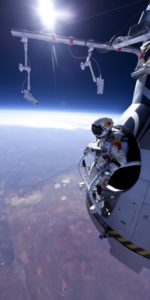[youtube_video]http://www.youtube.com/watch?v=oU8-YvSDmQA[/youtube_video]
Certain elements of this production use video provided courtesy of NASA
CAPE CANAVERAL, Fla – They have carried America’s space flight dreams on their shoulders for over four decades. Now, with a new era in space exploration potentially on the horizon – they are being readied for the future – they are NASA’s Crawler-Transporters. AmericaSpace toured inside these massive vehicles and spoke with United Space Alliance’s Terry Berman about the vehicles history – as well as their future.
Berman is a tall man who has worked to renovate the enormous tracked vehicles for the past year. The efforts of USA’s team of highly-skilled workers have seen these vehicles enter the 21st Century – far removed from their origins.

“NASA asked Marion Shovel if they could come up with something and they said, ‘yes, I think we can do something for you…,’” Berman said when asked about the crawler’s history.
NASA realized that it needed the crawler-transporters when the sheer size of the Saturn V rocket became apparent. The vehicles were built by Marion Power Shovel for the cost of $14 million each.
The normal distance that the crawlers traverse is approximately 3.5 miles. When asked what the crawlers top speed was, Berman responded “Two.” When not carrying their delicate cargo, the crawlers top out at around two miles an hour. When carrying a stack (launch vehicle) the team that operates the crawler prefers that the vehicle travel no faster than 0.8 miles-per-hour.
At the end of the Apollo Program, NASA repurposed the two vehicles for use in the space agency’s newly-minted shuttle program. The crawlers went on to serve NASA for 30 years moving the orbiters to (and in some cases back from) Launch Complex 39.

Now, NASA is looking into multi-tasking these vehicles, pushing them into service again and the tracked behemoths appear more than up to the task.
The space agency has been directed to restart exploration efforts with potential destinations including the Moon, asteroids, a Lagrange Point and perhaps, one day, Mars. NASA is planning to use the Space Launch System or “SLS” to ferry future astronauts to these destinations.
“When we took the ML (NASA’s new Mobile Launcher platform) out to pad to test her out, we got the crawler up to 1.2 miles-per-hour and she started to vibrate and we had to slow down,” Berman said when asked what efforts had already been conducted.

The test was just one small step to get NASA back in the business of human space exploration. The crawlers themselves are being refitted with technology that will allow them to continue service well into the 21st century.
The control rooms and cabins of the crawlers now employ touch screens. The engine rooms (plural – there are two of them each with two engines inside them within the crawler’s expansive interior) are being modernized. The AC generators within the crawler are brand new and the DC generators are being refurbished to make them “like new.” The engines aren’t the only thing new on the building-sized vehicle. The brakes have shiny new additions, as do other sections of the crawler. Not all of the vehicle was visible with elements draped in tarps and the view of other sections obstructed by scaffolding.

SLS is, in some ways, a mash-up between a Saturn V rocket and space shuttle. There is at least one thing that these three systems will share – the method of delivery to the launch pad. NASA is refitting elements of the two crawlers to be used on SLS. NASA, however, is also eyeing the crawlers for use in its commercial efforts as well.
In 2006, NASA was directed to begin the Commercial Orbital Transportation Services program or “COTS.” Since that time the agency has seen its directive change and has been tasked to turn over more and more of its low-Earth-orbit responsibilities to private firms. If the operators of the crawler-transporters have their way – these venerable machines will empower these fledgling companies on their individual trajectories as well.
To accomplish this, the 46-year-old crawlers are being modified so as to not only modernize them, but to see that they are more modular as well. What this means is that the crawlers will be able to support a wide range of launch vehicles and spacecraft.
Overseeing these changes is NASA’s Ground Systems Development and Operations Program which is based out of KSC. For his part, Berman welcomes the opportunity to use the crawlers for NASA’s commercial endeavors.
“These are durable machines and we would love to show just how versatile they are by delivering a variety of customers’ spacecraft to the pad,” Berman said as he looked up at the crawler.
Click here to learn more about the crawlers as well as other elements of NASA’s Ground Systems Development and Operations Program.






One Comment
One Ping
Pingback:United States and North American News | David Reneke | Space and Astronomy News